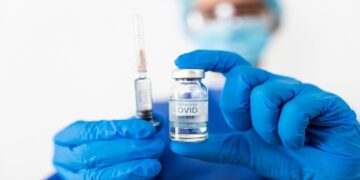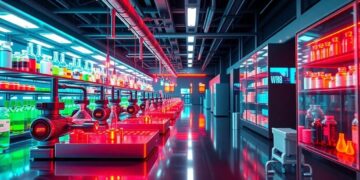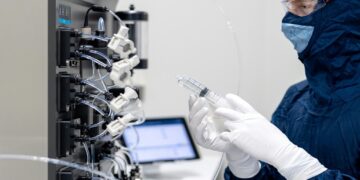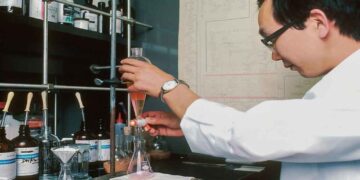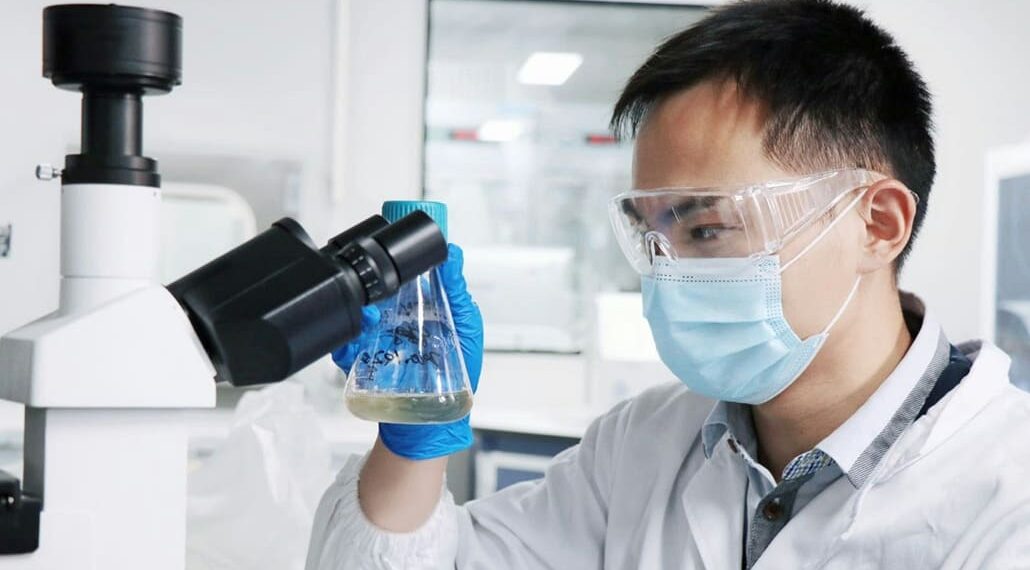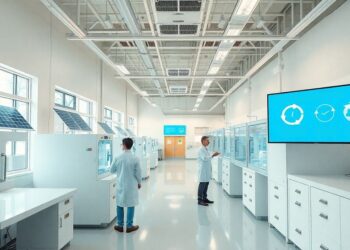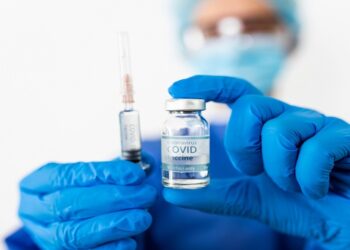Currently under development is a major shift towards constant bioprocessing in the biopharmaceutical industry. Unlike the traditional batch processing approach, which is distinguished by the existence of several stages and intermediate holding tanks, the consistent bioprocessing method runs without any disruptions. Cells are grown inside one linked system, and the product of interest is always gathered and refined. This not only removes the downtime between batches but also enables more efficient use of the tools and resources at hand.
With a compound annual growth rate (CAGR) of 22.4%, the present bioprocessing market is projected to be worth more than $218 million in 2023 and is expected to reach more than $599 million by 2028, according to one of the market research studies published. The main causes of this development are the rising demand for biopharmaceuticals, the increasing acceptance of continuous bioprocessing among contract manufacturing companies (CMOs) and contract manufacturing organisations (CMOs), and the benefits of continuous bioprocessing over batch and fed-batch modes of production.
Knowledge of Market Dynamics By use of PAT’s application to optimise continuous bioprocesses
Process analytical technology (PAT) is the name given to a system including analytical tools meant for monitoring and control of industrial processes. Apart from sensor technologies, tools for process analysis and testing (PAT) such as spectroscopy and chromatography enable continuous monitoring of important process parameters (CPPs) and critical quality attributes (CQAs) in real time. This helps manufacturers to quickly spot any kind of deviation and implement the required corrections to maintain the integrity of the process as well as the quality of the goods. The PAT advances and helps the producers maximise their operations in several spheres, including the following:
Process knowledge and control: PAT helps to deepen understanding of the bioprocessing environment by means of insights on links between the process parameters and product characteristics. This helps one to grasp the bioprocessing environment better. Manufacturers may make use of this knowledge to create advanced control systems including feedback control loops or even model predictive control, therefore optimising the process performance and ensuring consistency of the product.
By means of PAT-enabled optimisation, which simplifies bioprocessing operations, it is feasible to simplify opportunities for process intensification as well as efficiency gains, thereby reducing cycle durations and increasing productivity. By always monitoring and modifying process parameters, manufacturers may minimise cycle times, boost throughput, and even raise general productivity. This enables their progressive progress and goal attainment.
PAT is in line with the ideas that apply to quality by design (QbD) since it helps to build solid processes that go on to produce things regularly with the necessary quality traits. This enables manufacturers to go forward and include quality into the process from the very start, therefore lowering the risk related to product failures and deviations. One achieves this by including PAT instruments into the phases of design and development.
Apart from a cut in waste, production expenses also reduce. By means of consistent monitoring and control made available by PAT, one may help identify and minimise process inefficiencies, therefore lowering the raw material, energy, and waste generation amounts. Consequently, not only does this save production costs, but it also aids in the accomplishment of sustainability targets by lessening environmental negative effects.
Regarding the facilitation of regulatory compliance, PAT gives manufacturers the tools and the data they need to present to regulatory authorities demonstrating that they have a complete awareness of the process, that they have control over it, and that they are consistent with it. Using PAT helps producers to simplify regulatory filings, speed up product approvals, and guarantee compliance with strict regulatory criteria.
All things considered; PAT-enabled optimization has a significant potential in the continuous bioprocessing industry. This possibility motivates manufacturers to achieve higher degrees of process efficiency, quality, and regulatory compliance, therefore generating more revenues.
In terms of ongoing bioprocessing, high production and cost promote chromatography system appeal.
Product into chromatography systems with filtering systems along with devices; consumables; bioreactors; cell lines, cell culture medium, buffers, and reagents; also, other products divide the market for consistent bioprocessing. This is something one ought to give thought. Among other components, the chromatography systems and the consumables comprise resins, membranes, buffers, solvents, columns, reagents, and other consumables like autosamplers, fittings, and tubing detectors. Consistent chromatography techniques are absolutely essential for continual downstream bioprocessing if one is to get high protein purity. These advanced techniques offer a lot of interesting possibilities. One can keep the process running constantly by running several chromatography columns either countercurrent or even concurrent. This is so because the loading is done in the first column and all the other subsequent processes—elution, regeneration, washing, and re-equilibration—occur inside the next columns. Many chromatographic methods are part of the continuous mode of operation. Countercurrent chromatography (CCT), multicolumn countercurrent solvent gradient purification chromatography (MCSGP), simulated moving bed (SMB) chromatography, and continuous annular chromatography (CAC) among these methods.
Growing demand for biologics has led to the necessity for intensification of the upstream bioprocess in order to raise production and minimise manufacturing costs. This is so due to the growing biologics market. Several studies by the National Centre for Biotechnology Information (NCBI) show how well integrated continuous bioprocessing is applied in manufacturing monoclonal antibodies (mAbs). These studies have indicated that the technique works. For example, one-column continuous chromatography (OCC) and perfusion bioreactor culture using alternative tangential flow technology (ATF) allowed a researcher to get about an eighty percent boost in productivity.
Moreover, companies are fast shifting their focus to chromatography systems in order to fulfil growing industry needs and speed their manufacturing processes. Following that, Waters Corporation and Sartorius AG announced in June of 2023 their cooperation to create integrated analytical solutions for the biomanufacturing process occurring deeper downstream.
The value of approaching farther downstream
Aimed at isolating and purifying the expected biopharmaceutical product from the complex mixture related to cellular components, media, and contaminants generated during upstream production, downstream processes have a sequence of purification steps along with separation techniques. Along with accessories and other products connected with them, these activities sometimes produce items such cell filtration systems, devices, chromatography systems, and consumables. Particularly continuous chromatography systems are reinventing downstream purification by enabling continuous separation as well as the purification of biopharmaceutical products with exceptional precision and throughput. This represents a major advancement in the downstream goods purification process. Large biopharmaceutical companies have effectively applied both aqueous two-phase extraction, also known as ATPS, and periodic countercurrent chromatography, also known as PCC, continuous CTC, MCSGP, and SMB for the aim of continuous capture from the process development scale all the way up to the manufacturing scale. These businesses have been able to avoid the possible process bottlenecks this suggests. These experts help to enhance the cost of the goods, the quality of the output, and the effectiveness of the process. Two among the several resins used in the Protein A resin screening process are MabSelect Sure PCC-Cytiva and Poros ProA-Thermo Fisher Scientific. These resins are reachable all during the process’s continuous capture phase. Apart from compound development and manufacturing companies (CDM), it is expected that more mid-sized biotech companies will arise in the next few years.
Some of the elements driving the high share of the segment in the market are the growing demand for biopharmaceuticals; rising technological advancements like single-pass tangential flow filtration and multicolumn chromatography; the increasing need for intensification of the downstream bioprocess as a result of an increased titer; and lowering production costs in the case of biosimilars and innovator drugs. These elements help the segment to have a significant market share.
An Application-Based Study of the Market for Ongoing Bioprocessing
Among the applications included in the consistent bioprocessing market segmentation are mAbs, vaccines, cell and gene therapy, and other ones. Application drives this segmentation of the market. It so happens that one of the most important subgroups of biotechnology medicine is monoclonal antibodies. The growing pharmaceutical research and development drug pipeline, the increasing emphasis on continuous bioprocessing in the manufacturing of monoclonal antibodies, the expanding clinical pipeline of monoclonal antibodies, and the growing regulatory approvals pertaining to therapeutic antibodies help to explain both the great share as well as the high growth rate inside this segment. These elements taken together have helped the segment to flourish.
Continuous bioprocessing is rapidly gaining speed in monoclonal antibody bioprocessing, so it has the potential to offer several advantages like smaller facility footprints, less investment costs, more flexibility, and economies of process. Once mammalian cell-derived monoclonal antibodies (mAbs) became commercially successful, demand for breakthrough single-use bioreactor systems surged. These technologies can reduce prices and provide far better degrees of flexibility and productivity. The successful proving of the viability of a completely integrated continuous process from the pilot size bioreactor to the therapeutic substance has led to research that has opened the road for its larger application within the industry.
Two more elements driving the growth of the market within this specific category are the increasing frequency of cancer and the growing necessity for cancer therapies. Monoclonal antibodies (mAbs) on the other hand have less side effects than chemotherapy. Another important factor driving the growth of the market is the emergence of new, more efficient and effective monoclonal antibody (mAbs) classes, such anti-PCSK9 monotherapy. Among the most effective monoclonal antibodies (mAbs), including Humira, Rituxan, Avastin, and Pembrolizumab-Keytruda, some have patents set to expire in the next few years. Patents have been lost, hence biopharmaceutical companies have been forced to proceed with including monoclonal antibodies (mAbs) into their drug manufacturing process. Regarding affordable solutions like continuous bioprocessing, demand is predicted to rise given the expanding pharmaceutical drug pipeline as well as the increasing number of regulatory approvals for the modular drug delivery systems (mABs).
Final Thoughts
Now leading the front stage in innovation is the constant bioprocessing sector, which will help to revolutionise manufacturing processes for pharmaceuticals worldwide. This is something one should give careful thought. Consistent bioprocessing provides advantages unmatched in terms of efficiency, productivity, and quality control when compared to conventional batch methods. This is so because continuous, smooth production flow of consistent bioprocessing is what drives An increasing demand for biopharmaceuticals, the rise of integrated end-to–end continuous bioprocessing, government and regulatory initiatives for favourable innovative technologies, and a rising acceptance among both contract manufacturing organisations (CMOs) and contract manufacturing organisations (CMOs) are driving the market under several angles. Indeed, the acceptance of continuous production techniques by pharmaceutical manufacturers is causing the market to develop fast and show diversity. Beginning with the upstream cell culture and fermentation operations and working all the way down to the downstream production processes of purification and formulation, continuous bioprocessing systems are applied across the whole biopharmaceutical manufacturing process. Furthermore adding to the improvement of process control and optimization—which finally yields higher efficiency and guarantees regulatory compliance—process analytical technology, sometimes referred to as PAT, in addition to automation.





